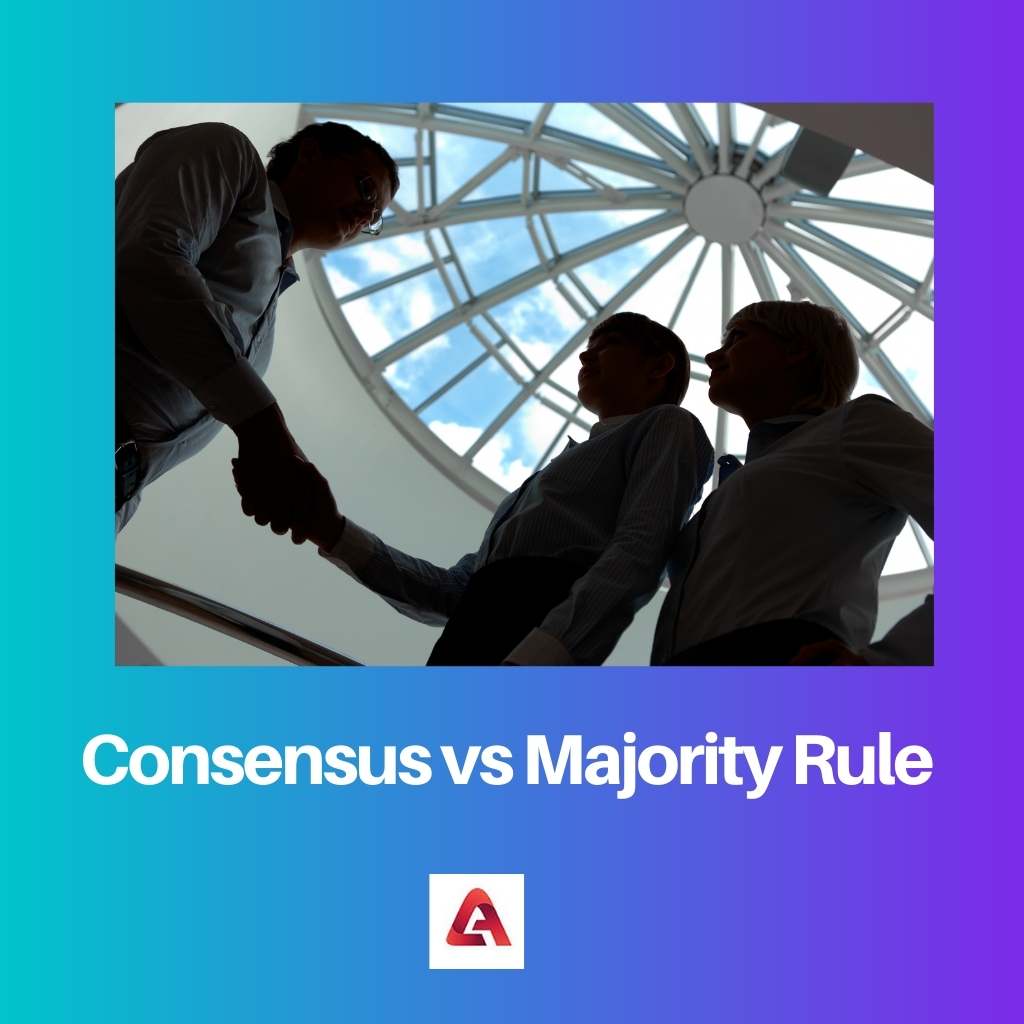The decision-making process is carried out to reach a conclusion by different methods.
When a group discussion takes place, this decision-making process helps in making a decision efficiently and quickly, although they have pros and cons.
Consensus and Majority rule are some of the decision-making processes. They are very different from each other in the process and in its basics. Both are used according to the situation.
Key Takeaways
- Consensus decision-making involves reaching an agreement that all group members can support. At the same time, majority rule entails making decisions based on the preference of more than half of the group members.
- Consensus promotes collaboration, inclusivity, and a sense of shared ownership, while majority rule allows for quicker decisions and clear outcomes.
- Consensus can be time-consuming and challenging in large groups, whereas majority rule can leave minority opinions unaddressed.
Consensus vs Majority Rule
Consensus means a general agreement that is attained by the participation of everyone in the decision-making process. Everyone involved has to agree collectively. Majority rule is a decision-making process that only requires the votes majority of people to make a decision without a collective agreement.

Consensus needs the participation of everyone during the decision-making process. And for the decision, everyone needs to agree collectively rather than being in different groups.
Besides, the environment is indeed healthier, as there should be collective agreement. Thus, communication must be subtle. In addition to that, collective decision-making makes it longer to come up to a conclusion.
Lastly, minority opinionated people may fall into groupthink in consensus.
The majority rule is the fastest decision-making process as it doesn’t require a collective agreement. Thus, the majority rule out the minority in this case.
To an extent, the minority may express an opinion, but only the majority’s decision is taken into consideration. The majority rule allows it to choose its decision irrespective of the final majority decision.
And, it can be burdening for minorities as the majority can be oppressive as well.
Comparison Table
| Parameters of Comparison | Consensus | Majority Rule |
|---|---|---|
| Agreement | Consensus needs collective agreement for the final decision. | The majority rule relies on the majority’s opinion. |
| Address | Consensus addresses both sides. | In majority rule, only majority opinions are understood. |
| Disagreement | Consensus comes to a middle ground if there’s a disagreement. | In majority rule, the majority’s opinion rules out the minority’s opinion. |
| Duration | Consensus takes a longer time for decision-making. | The majority rule quickly comes to a decision. |
| Minority Rights | In consensus, minority opinion leads to disagreement implying the rights of minorities. | There are no rights for minorities in majority rule. |
What is Consensus?
Consensus is a decision-making process that requires a collective agreement to rule out a decision. Both opinions are heard and understood then a solution comes up that respects both sides and comes to a mutual negotiation.
Moreover, it cannot be considered a majority decision or unanimity. Every person has a choice to choose their opinion. However, to come up to a consensus, a collective agreement is a must.
‘Consent’ is the basis of consensus. Therefore if any side disagrees, there is still a requirement to get overall consent to achieve an agreement that respects both opinions.
For issue need to be settled, cooperation between both sides is necessary.
Consensus is neither a majority rule nor unanimity, as consensus relies on collective agreement. Every single opinion matters in this type of decision-making.
Although it addresses every disagreement, it may not fully fit into the decision. If more than 51% of people prefer an option, even though it may not come to a consensus as it’s not enough.
A consensus is hard to come up with, as there’s no middle option, although the middle option could be insufficient.
But, coming to how a consensus can be reached if every argument is understood, then deducing to come up to a common ground and find the best solution from it. Hence, consensus can come through a collective agreement.

What is Majority Rule?
The majority rule is also a decision-making process that rules out minority opinions. Every person has an opportunity to choose their view freely without regarding the formation of either majority or minority.
It is a binary decision. If an opinion gets more than half agreement, then that opinion rules out the minority opinion. It is commonly achieved in the most influential decision-making bodies.
According to Kenneth May, the majority rule is considered reasonable because it endorses fairness, anonymity, neutrality, decisiveness, and monotonicity.
Furthermore, every vote counts as identical. Therefore it doesn’t matter who casts a vote. And decisions are made quickly in contrast to consensus.
Moreover, the collective agreement can be cyclic, yet the majority rule relies on the choice to change their opinion. So, there is a possibility of a change of decision every time.
The majority rule is very vulnerable as there’s a possibility that a shift in opinion can turn the tables.
As for the limitations, minority rights are subsidiary as the majority has the most power in every aspect. The majority can move to the tyranny of majority rule by putting minorities back without any rights.
Secondly, it can lead to imprecise priorities because the majority group may consider what they think is essential rather than significant priorities.
Lastly, it may be recognized as an arrogant culture and conflict due to leaning on one side.

Main Differences Between Consensus and Majority Rule
The decision-making process can be nerve-wracking and stressful, yet necessary. There are different methods for decision-making, such as consensus and majority rule.
Each type has its pros and cons. Consensus and majority rule are some of the decision-making processes that are commonly used. Both are very different from each other ranging from participation to final decision.
- Consensus requires collective agreement, including minority, while majority rule focuses on majority opinion for the final decision.
- Consensus addresses both sides. Meanwhile, majority rule revolves around the majority only.
- Consensus comes up to a common ground if there is a disagreement, while in majority rule, the minority opinion prevails over the majority.
- Consensus takes a longer time to agree. Meanwhile, majority rule is fast in decision-making.
- In consensus, minority opinion leads to disagreement implying the rights of minorities, while in majority rule, the minority has no rights.

An illuminating comparison of consensus and majority rule, providing a comprehensive understanding of the intricacies involved in these decision-making processes.
This article provides valuable insights into the consensus and majority rule decision-making processes, enriching the understanding of both methods and their applications in various scenarios.
The article effectively highlights the contrasting features of consensus and majority rule, making it easier to comprehend the strengths and limitations of each approach.
Indeed, understanding the nuanced differences between consensus and majority rule equips individuals with the knowledge necessary to navigate group decisions effectively.
The article’s thorough exploration of consensus and majority rule offers valuable insights into the decision-making dynamics within group scenarios, promoting informed and thoughtful approaches to making collective decisions.
This article provides a clear comparison between consensus and majority rule, bringing to light the implications of using each process. An essential read for anyone looking to understand these decision-making methods.
Interesting article that comprehensively compares consensus and majority rule in the decision-making process. It’s crucial to understand the distinctions between the two to make informed decisions in group settings.
Absolutely, the article provides a detailed analysis that highlights the strengths and weaknesses of both methods. This information is valuable for anyone involved in group decision-making.
Agree with you both, well-researched article with insightful information. It definitely broadens the knowledge of different decision-making processes.
The article’s thorough analysis provides an in-depth understanding of consensus and majority rule. It’s crucial to grasp the differences between the two methods, especially in a group decision-making context.
Absolutely, the article delves into the complexities of both processes and the potential challenges they pose in achieving efficient decision-making outcomes.
This article emphasizes the importance of comprehending the nuances between consensus and majority rule, shedding light on the complexities and implications of each decision-making process.
Absolutely, gaining a deeper understanding of these methods is essential for fostering effective communication and collaboration within group settings.